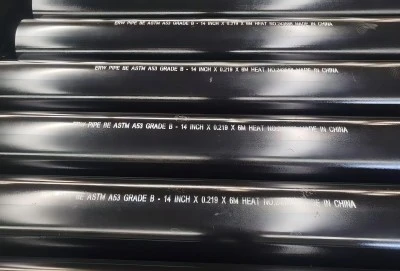Electric resistance welded (ERW) steel pipes have become an integral part of various industries due to their versatility, strength, and cost-effectiveness. As technology advances, two primary methods of ERW pipe production have emerged: High-Frequency (HF) ERW and Low-Frequency (LF) ERW. In this comprehensive guide, we'll explore the differences between these two processes, their welding mechanisms, process parameters, efficiency, and applications.
|
|
|
Welding Mechanism & Heat Generation
The fundamental principle behind ERW pipe production is the use of electrical resistance to generate heat and fuse the edges of a steel strip. However, HF ERW and LF ERW differ significantly in their approach to heat generation and welding mechanisms.
High-Frequency (HF) ERW:
HF ERW utilizes frequencies ranging from 100 kHz to 800 kHz. This high-frequency current is applied to the pipe edges through sliding contacts or induction coils. The key advantages of HF ERW include:
- Localized heating: The high-frequency current concentrates heat at the pipe edges, minimizing the heat-affected zone.
- Rapid heating: The process achieves welding temperatures quickly, reducing overall heat input.
- Precise control: The narrow heat-affected zone allows for better control of the welding process.
In HF ERW, the current follows the path of least resistance along the surface of the metal due to the skin effect. This phenomenon ensures that the heat is concentrated precisely where it's needed, resulting in a clean, consistent weld seam.
Low-Frequency (LF) ERW:
LF ERW, also known as contact welding, uses frequencies between 50 Hz and 400 Hz. The current is applied directly to the pipe through contact electrodes. Key characteristics of LF ERW include:
- Broader heat-affected zone: The lower frequency results in deeper penetration of the current into the metal.
- Slower heating: The process takes longer to reach welding temperatures compared to HF ERW.
- Higher current requirements: LF ERW typically requires higher current levels to achieve the necessary heat for welding.
In LF ERW, the current flows through the entire thickness of the metal, generating heat throughout the material. This can lead to a larger heat-affected zone and potential changes in the material properties around the weld.
Understanding these fundamental differences in heat generation and welding mechanisms is crucial for selecting the appropriate ERW process for specific applications and materials.
Process Parameters & Efficiency
The efficiency and quality of ERW pipes depend heavily on various process parameters. Let's explore how these parameters differ between HF ERW and LF ERW, and their impact on production efficiency.
High-Frequency (HF) ERW Parameters:
- Frequency: Typically 100-800 kHz
- Welding speed: Generally higher, up to 150 m/min for smaller diameter pipes
- Power input: Lower power requirements due to concentrated heating
- Squeeze pressure: Precise control required to ensure proper fusion
- Cooling rate: Rapid cooling possible due to localized heating
HF ERW offers several efficiency advantages:
- Higher production speeds, especially for smaller diameter pipes
- Lower energy consumption per unit length of weld
- Reduced material waste due to narrower heat-affected zone
- Better weld quality with fewer defects
Low-Frequency (LF) ERW Parameters:
- Frequency: 50-400 Hz
- Welding speed: Generally lower, typically up to 60 m/min
- Power input: Higher power requirements due to broader heating area
- Squeeze pressure: Less critical due to broader fusion zone
- Cooling rate: Slower cooling due to more extensive heat-affected zone
LF ERW has its own set of efficiency considerations:
- Lower initial equipment costs
- Simpler maintenance requirements
- Better suited for thicker materials and larger diameter pipes
- More forgiving of minor variations in edge preparation
The choice between HF and LF ERW often comes down to a balance between production speed, energy efficiency, and the specific requirements of the end product. For instance, HF ERW is generally preferred for thin-walled, small to medium diameter pipes where high production speeds are crucial. On the other hand, LF ERW might be more suitable for thicker-walled pipes or applications where the initial investment cost is a significant factor.
It's worth noting that advancements in both technologies have narrowed the gap in some areas. Modern LF ERW systems have improved in speed and efficiency, while HF ERW equipment has become more versatile in handling a wider range of pipe sizes and wall thicknesses.
Applications
Electric resistance welded steel pipes find applications across numerous industries due to their excellent strength-to-weight ratio, consistent quality, and cost-effectiveness. The choice between HF ERW and LF ERW pipes often depends on the specific requirements of the application. Let's explore some common applications for each type:
High-Frequency (HF) ERW Pipe Applications:
- Oil and Gas Industry: HF ERW pipes are widely used in oil and gas transportation due to their excellent weld quality and ability to withstand high pressures. They're commonly used for:
- Gathering lines in oil fields
- Distribution pipelines for natural gas
- Offshore pipeline systems
- Construction and Infrastructure: The consistent quality and strength of HF ERW pipes make them ideal for:
- Structural support in buildings
- Piling for foundations
- Water and sewage systems
- Automotive Industry: HF ERW pipes are used in various automotive applications, including:
- Exhaust systems
- Fuel lines
- Structural components
- Furniture and Home Appliances: The smooth finish and precise dimensions of HF ERW pipes make them suitable for:
- Furniture frames
- Exercise equipment
- Appliance components
Low-Frequency (LF) ERW Pipe Applications:
- Heavy Construction: LF ERW pipes are often preferred for applications requiring thicker walls and larger diameters, such as:
- Bridge construction
- Heavy-duty piling
- Industrial structural supports
- Agricultural Sector: The durability and cost-effectiveness of LF ERW pipes make them suitable for:
- Irrigation systems
- Fencing posts
- Farm equipment components
- Power Generation: LF ERW pipes find applications in power plants for:
- Cooling water systems
- Steam lines
- Structural supports for equipment
- Marine Applications: The ability to produce larger diameter pipes makes LF ERW suitable for:
- Ship building
- Offshore platform construction
- Port infrastructure
It's important to note that the boundaries between HF and LF ERW applications are not always rigid. Advances in both technologies have expanded their respective capabilities, and the choice often depends on factors such as production volume, available equipment, and specific project requirements.
When selecting between HF and LF ERW pipes, considerations such as wall thickness, diameter, production speed, and the specific mechanical properties required for the application play crucial roles. Additionally, industry standards and regulations often dictate the type of ERW pipe that can be used for certain applications, particularly in critical sectors like oil and gas or construction.
About Longma Group
Both High-Frequency (HF) and Low-Frequency (LF) ERW processes have their unique strengths and are continually evolving to meet the demanding needs of various industries. HF ERW excels in producing high-quality welds at rapid speeds, making it ideal for applications requiring precise, consistent welds in smaller to medium-sized pipes. On the other hand, LF ERW remains a cost-effective solution for larger diameter pipes and thicker materials, with recent advancements narrowing the gap in production speeds and weld quality.
The choice between HF and LF ERW ultimately depends on the specific requirements of your project, including factors such as pipe diameter, wall thickness, production volume, and the intended application. As the demand for high-quality, efficient piping solutions continues to grow across industries, staying informed about the latest developments in ERW technology is crucial for making the best decision for your needs.
Longma Group is here to meet your needs. We specialize in producing electric resistance welded steel pipes with a wide range of standards, including ASTM A53 Gr.B; API 5L: Gr.B, X42, X46, X52, X56, X60, X65, X70, X80 PSL1 and PSL2; ASTM A252, ASTM A500, AS/NZS 1163, AS/NZS1074, EN10219, EN10217 and more. Our products feature an outer diameter of 1/4"-20" (13.7mm--508mm), thickness of SCH10-SCH160 (6.35mm-59.54mm), and length from 6m to 18m, with options of BE (Beveled Ends) and PE (Plain Ends). Whether you require HF or LF ERW pipes, our expert team can guide you to the best solution for your project. Don't miss the opportunity to enhance your business with our excellent steel pipes. Contact us now at info@longma-group.com to explore how we can be your reliable partner in steel pipe solutions.














